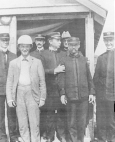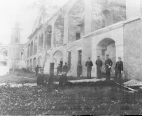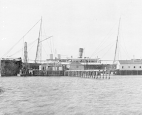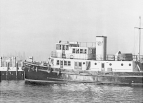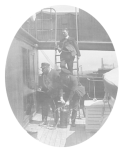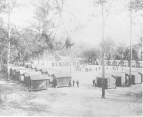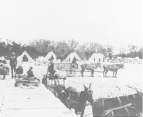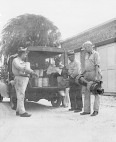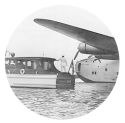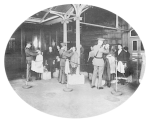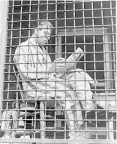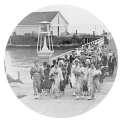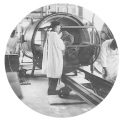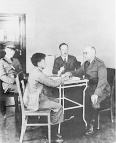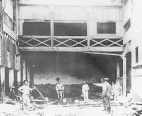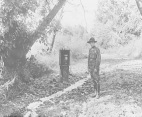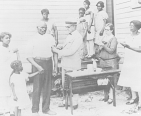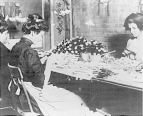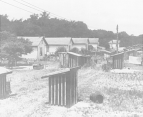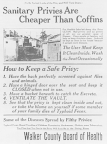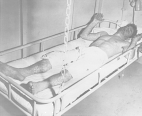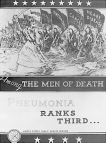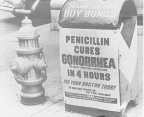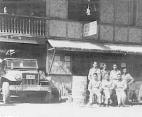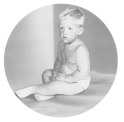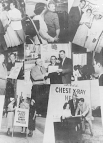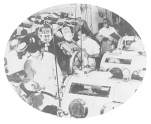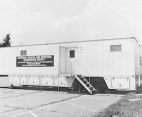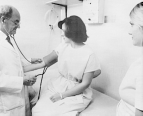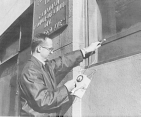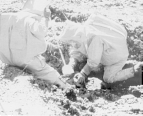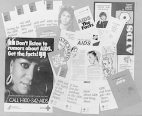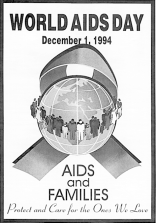 Disease Control and Prevention
Disease Control and Prevention
Fighting the Spread of Epidemic Diseases
By 1878 the Marine Hospital Service had begun to lose its identity as a relief organization solely for sick seamen. The prevalence of major epidemic diseases such as smallpox, yellow fever, and cholera spurred Congress to enact a national law in 1878 to prevent the introduction of contagious and infectious diseases into the United States, later extending it to prevent the spread of disease among the states. The task of controlling epidemic diseases through quarantine and disinfection measures as well as immunization programs fell to the Marine Hospital Service and hastened its evolution into the Public Health Service which served the whole nation.
As a result of new laws the functions of the Service expanded greatly to include the supervision of national quarantine, the medical inspection of immigrants. the prevention of interstate spread of disease, and general investigations in the field of public health, such as that of yellow fever epidemics. To help the Service meet these increased tasks the Congress in 1889 established the Commissioned Corps along military lines, with titles and pay corresponding to Army and Navy grades. In 1930 and 1944 the Corps was expanded to include, besides physicians, engineers, dentists, research scientists, nurses, and other health care specialists.
As epidemic diseases were brought under control the Public Health Service began to shift its attention to other areas such as cancer, heart disease, health in the workplace, and the impact of environmental problems, such as toxic waste disposal, on health. But the Public Health Service is still called upon to investigate outbreaks of disease such as Legionnaire's, toxic shock syndrome, and now the deadliest epidemic of our age -- AIDS. Much of the work of the early plague fighters and sanitarians is now carried out by the scientists at the Centers for Disease Control and Prevention (CDC) in Atlanta, Georgia.
Gallery
Public Health Service officers in uniform at the Montauk Point, New York, Quarantine Station. An Act of Congress in 1870 formally organized the Marine Hospital Service as a national agency with centralized administration under a medical officer, the Supervising Surgeon, who was later given the title of Surgeon General. The Service was reorganized along military lines, with uniforms, entrance examinations, and tenure and promotion on the basis of merit, free from politics. Gradually, local physicians were replaced with medical officers, who were admitted only after examination and were subject to assignment wherever required.
1898
Public Health Service officers in front of the quarantine hospital in the Dry Tortugas, Florida. Ravaging epidemics, which were taking their toll on the United States population, and the continued failure of the Federal Government to exert its proper authority in quarantine matters stimulated John M. Woodworth, the first Surgeon General of the Marine Hospital Service, to press for action in developing an effective national quarantine system. Largely through his efforts the national quarantine act "to prevent the introduction of contagious or infectious diseases into the United States" was passed in 1878. This legislation also gave authority for the very important Public Health Service publication now known as Public Health Reports.
c. 1895
North end of the disinfecting wharves at the quarantine station on Blackbeard Island, Georgia. This station for the detention and treatment of infected ship crews and cargoes, together with another quarantine station on Sapelo Sound in Georgia, were established in 1883 as part of a national quarantine system. They constituted part of the South Atlantic Quarantine region.
1895
The Public Health Service quarantine boarding launch "Walter Wyman" in New York City harbor. Walter Wyman was Surgeon General of the Public Health Service from 1891 to 1911 and among his many accomplishments was the development of the national maritime quarantine system.
1939
Fumigation of a ship in New York City harbor by spraying of hydrocyanic acid gas. The introduction of hydrocyanic acid gas by the Public Health Service in 1913 to replace sulphur dioxide the chief fumigant relied upon for centuries was a very important contribution to quarantine procedure.
c. 1914
Camp E. A. Perry, yellow fever detention camp, on the south bank of St. Mary's River in Florida near the Georgia border, established by the Marine Hospital Service in 1888. During the spring and summer of that year there were numerous outbreaks of yellow fever in the gulf states. The Service assisted state and local health authorities in controlling its spread by setting up camps such as this. Persons traveling from yellow fever areas were required to remain in the camp for the incubation period (6-10 days) before proceeding elsewhere. This camp which was up for several weeks, was named in honor of Governor E. A. Perry of Florida, who cooperated in establishing and maintaining it. Camps near infected cities were not new, but an inland quarantine, where suspects were detained only long enough to demonstrate that they were not infected and then allowed to proceed, were new at the time.
1888
United States troops in the Spanish-American War suffered from yellow fever. Fear of its spread to the mainland after the end of hostilities in 1899 invoked large-scale efforts by the Marine Hospital Service to ensure adequate quarantine inspection of troops being returned from Cuba and Puerto Rico. Here troops are undergoing inspection and disinfection of baggage at the quarantine detention camp on Daufuskie Island South Carolina.
1899
A fumigating and disinfecting team getting ready to work in New Orleans.
1939
Quarantine inspection in Baltimore harbor. Unless specifically exempted by regulation, every ship, aircraft, or other carrier entering a United States port is examined for purposes of quarantine.
1939
The immigration law of 1891 made it mandatory that all immigrants coming into the United States be given a health inspection by the Public Health Service physicians. The law stipulated the exclusion of "all idiots, insane persons, paupers or persons likely to become public charges, persons suffering from a loathsome or dangerous contagious disease," and criminals. The largest inspection center was on Ellis Island in New York Harbor. Here the physicians are looking at the eyes for signs of trachoma.
c. 1910
Quarantine detention at Immigration Station on Ellis Island, New York. Those suspected of having a communicable disease were segregated at once and, after confirmation of the diagnosis, admitted to the communicable disease hospital for care and treatment.
c. 1930
Asian immigrants arriving at the Immigration Station on Angel Island near San Francisco, California. Angel Island was one of about 50 American ports designated as ports of entry for immigrants by the immigration law of 1891.
1931
Disinfecting clothing of immigrants at the Immigration Station on Angel Island, San Francisco, California.
1931
Testing an Asian immigrant at the Immigration Station on Angel Island, San Francisco, California
1931
The foreman of a ratproofing crew in New Orleans, Louisiana, pointing out the progress of the work to Public Health Service officer Dr. Charles V. Aiken. Bubonic plague broke out in New Orleans in June 1914. Full plague control operations such as this continued until 1916 when the city was declared free of infection.
1914
Two sisters suffering from trachoma, a contagious chlamydial disease of the eye which, if untreated, could lead to blindness. Because of its prevalence Congress and President Woodrow Wilson authorized the Public Health Service in 1913 to use money from its annual "epidemic" fund for the prevention and control of trachoma.
c. 1920
Sanitary engineer Ralph E. Tarbett oversees malaria control work during World War I. A drip can containing oil and kerosene is used to eliminate a mosquito-breeding area. Starting in 1912 and 1913 malaria studies and malaria control efforts were led by Public Health Service officer Henry R. Carter and Rudolph H. von Ezdorf. From 1912 to 1917 the main effort was directed toward determining where malaria was prevalent in the United States and measuring its economic impact.
c. 1917
Typhoid fever attributable to poor sanitary conditions, was a major cause of illness in the United States during the 19th and early 20th centuries, especially in the rural areas. Here an entire family receives inoculations against typhoid fever.
c. 1930
The working environment and its effect on worker's health became a major area of study for the Public Health Service starting in 1910. Investigations in the garment making industry, as illustrated by these women making flowers, revealed unsanitary conditions and an excessive rate of tuberculosis. Other studies were done of silicosis among miners, sanitation and working conditions in the steel industry, lead poisoning in the pottery industry, and radiation hazards in the radium dial painting industry. These studies and surveys were coordinated by the Division of Industrial Hygiene and led by such officers as Joseph W. Schereschewsky. They eventually helped to better health conditions and provided safer work environments for many workers.
c. 1910
Rural sanitary surveys conducted by the Public Health Service under the leadership of such officers as Leslie L. Lumsden (1875-1946) and Charles W. Stiles (1867-1941) tried to ascertain the health conditions in rural areas of the United States through house-to-house canvasses. Working in close cooperation with local officials, the public health survey teams also provided advice to these households concerning the safe disposal of human wastes by building sanitary privies, the protection of water supplies by safeguarding wells to prevent surface drainage, and the screening of homes to prevent the entrance of disease-bearing insects, particularly flies and mosquitos. The construction of sanitary privies for each household, such as these shown here in an agricultural migrant village, played an important part in the development of rural sanitation. This work was greatly advanced during the 1930s through the federal privy-building programs of the Civil Works Administration and the Work Projects Administration.
c. 1930
The Public Health Service rural sanitary surveys during the first two decades of the 20th century led to the establishment of many local county health boards and departments who continued the work of rural sanitation on a daily basis. Health education was one of their primary tools. The poster for privies printed for one of Dr. Lumsden's county health campaigns is an example of the methods used. The results were quite dramatic as the incidence of typhoid fever and hookworm markedly diminished in areas where active sanitary measures were taken.
c. 1920
Smallpox has been one of the most devastating diseases in American history especially among Native Americans. Sporadic cases of smallpox were still being reported in the United States during the 1930s and early 1940s. The Public Health Service primarily through the work of the Hygienic Laboratory, played an important role in controlling and finally eradicating this disease. Important contributions included the inspection of vaccine being produced to ensure purity. especially from contamination with tetanus; recommending the abandonment of dressings at the vaccination site to avoid post vaccination tetanus; and the development of the multiple pressure method of vaccination.
c. 1920
Pneumonia was a serious concern of the Public Health Service in the early decades of the 20th century. Together with influenza it was the leading cause of death in the United States in 1900.
c. 1930
This World War II advertisement informs the soldiers and other citizens about a new wonder drug that can cure venereal disease. The introduction of penicillin, first in limited amounts in 1943 for clinical trials and then in massive quantities by 1944 as a result of the war effort, brought about revolutionary changes in the control of infections and venereal disease. The Public Health Service together with other government agencies carried out an extensive study of the effect of penicillin in treating syphilis and gonorrhea.
c. 1944
The Malaria Control Unit of the Philippines Public Health Rehabilitation Program in front of their headquarters. Following the reoccupation of the Philippines by the United States Armed Forces in 1945 and until 1950 the Public Health Service aided the Philippine government in surveying the general public health conditions on the Islands and reestablishing public health programs and quarantine facilities. The prevention and control of malaria with four to five million cases annually was a major objective of the program.
c. 1946
Medical discoveries and public health campaigns have almost eliminated deaths from the common diseases of childhood such as measles, diphtheria, scarlet fever, and whooping cough. As a result of these successes nearly 20 years were added to the average life expectancy at birth between 1900 and 1950-from 47 to 67 years.
c. 1950
A collage of well known personages who gave publicity and support to a chest X-ray campaign in Los Angeles. During 1950 more than 2 million X-ray examinations were made by the Public Health Service, more than 1.8 million of them in community-wide chest X-ray surveys in Denver, Boston, Salt Lake City, San Diego, and Los Angeles.
c. 1950
The iron lung was used to sustain the lives of polio victims. Dr. James P. Leake and other Public Health Service scientists were instrumental in field investigations of poliomyelitis.
c. 1950
Accurate health statistics are very important for formulating national health policies and funding health programs. This specially designed and equipped mobile examination center is the site of testing for the third National Health and Nutrition Examination Survey (NHANES III). NHANES III is designed to assess the health and nutritional status of adults and children in the United States and is being conducted by the National Center for Health Statistics of the Centers for Disease Control and Prevention. Approximately 40,000 individuals in 88 communities across the country will be asked to participate in this six-year survey which began in September 1988. The first two national surveys were done in l971-75 and l976-80.
c. 1988
Persons who participate in the third National Health and Nutrition Examination Survey receive a physical examination and several other tests from a physician and a highly trained medical staff. These other tests will include a dental examination, hearing test, allergy skin test, lung capacity test, body measurement, electrocardiogram (ECG), and measurement of bone density.
c. 1988
Public Health Service officer Gail Schmidt checking the level of contamination on the exterior of a building used by radium source manufacturer and importer in New York. Health hazards associated with radioactive materials have been a concern for the Service throughout most of this century. Since 1979 the Centers for Disease Control and Prevention in Atlanta, Georgia have had the primary responsibility of responding to environmental emergencies involving radiation and chemicals such as those caused by spills during transport fires, and other incidents. They assisted in the environmental epidemiologic investigation following the Three Mile Island nuclear reactor accident in 1979.
1966
Not only did the Centers for Disease Control and Prevention take over the foreign quarantine functions in 1967 they also extended quarantine into space. The Centers for Disease Control and Prevention provided quarantine equipment and procedures for the United States space program, including the Apollo moon landings.
c. 1969
Wearing high-level protective gear Public Health Service response teams collect samples for toxic substance identification. Since 1979 the Centers for Disease Control and Prevention (CDC) have coordinated activities to protect the public's health against exposure to toxic chemicals in the environment. The Center for Environmental Health and the National Institute for Occupational Safety and Health (NIOSH) are the two organizational units within the CDC responsible for these activities. They include studies of indoor air quality, lead-based paint poisoning, and occupational exposure to asbestos and hundreds of other toxic and carcinogenic substances. Health studies of residents of Love Canal, an abandoned chemical waste dump in Niagara Falls, New York, in 1980 was one of their most well-known efforts.
c. 1980
Health education is an important tool in the fight against the spread of AIDS. Surgeon General C. Everett Koop's Report on AIDS and other brochures produced by the Public Health Service help to disseminate important information about AIDS.
1987



